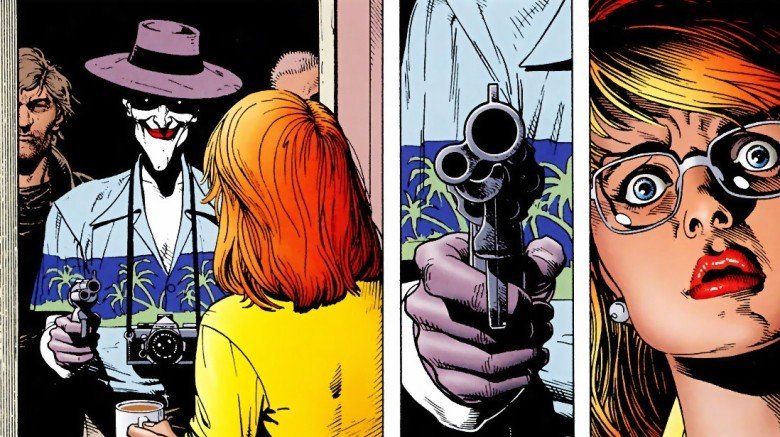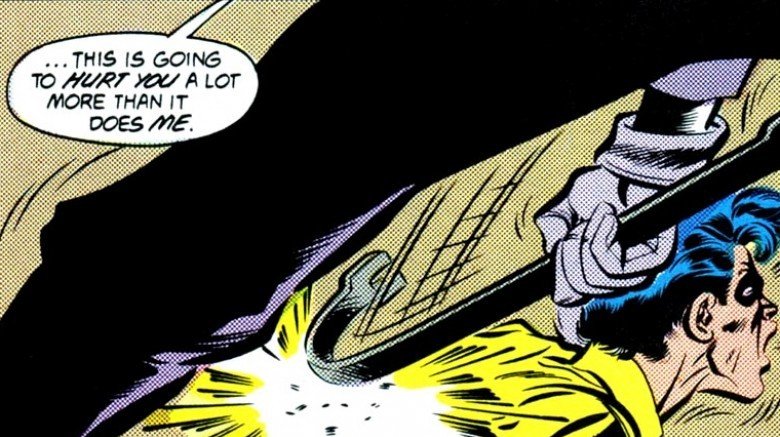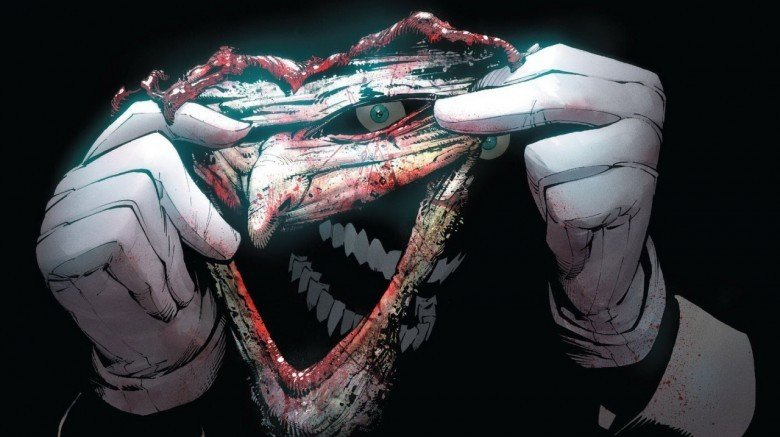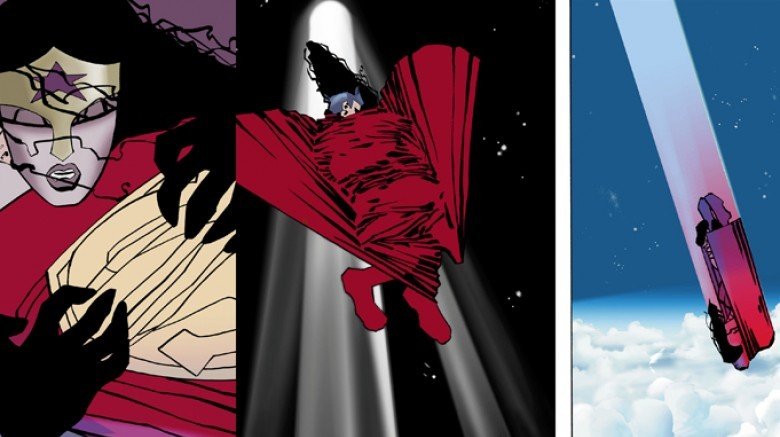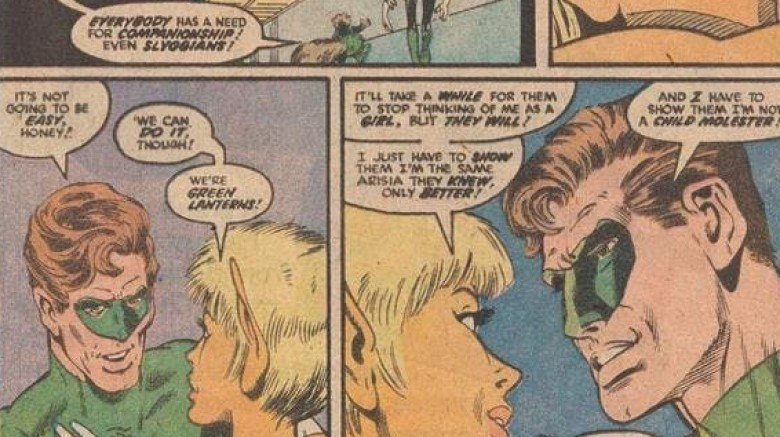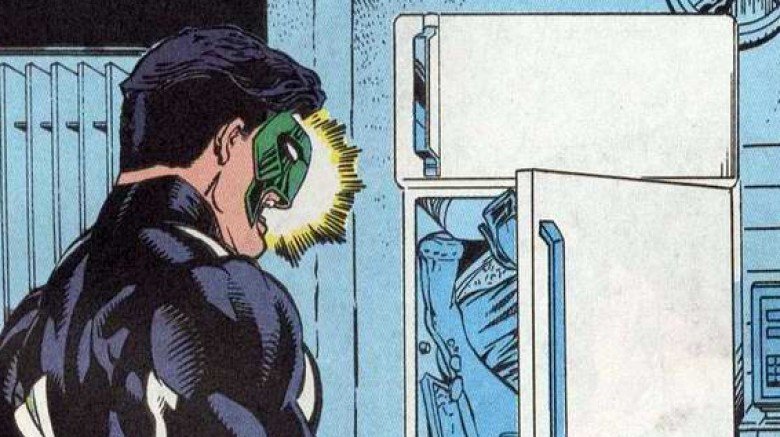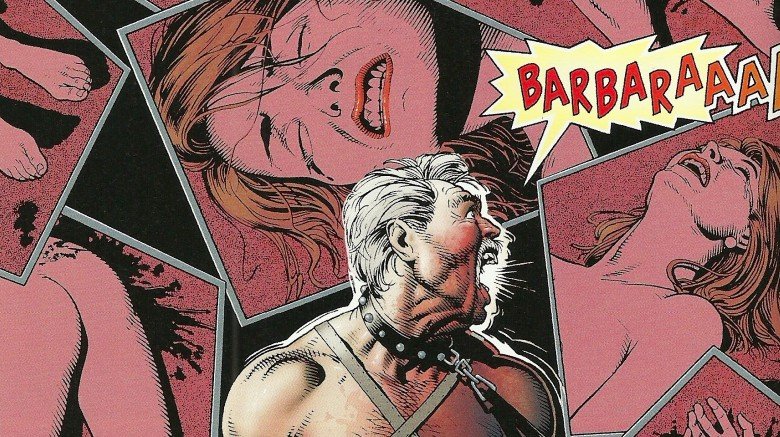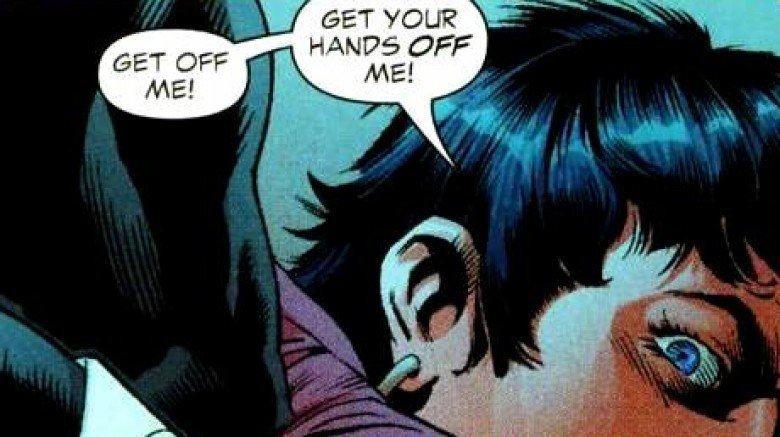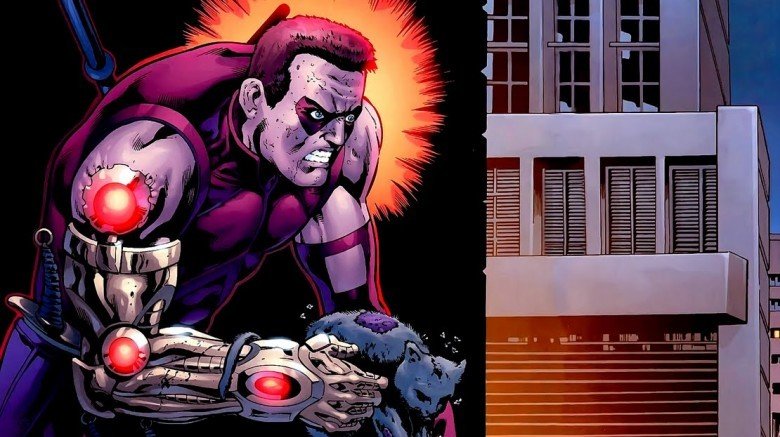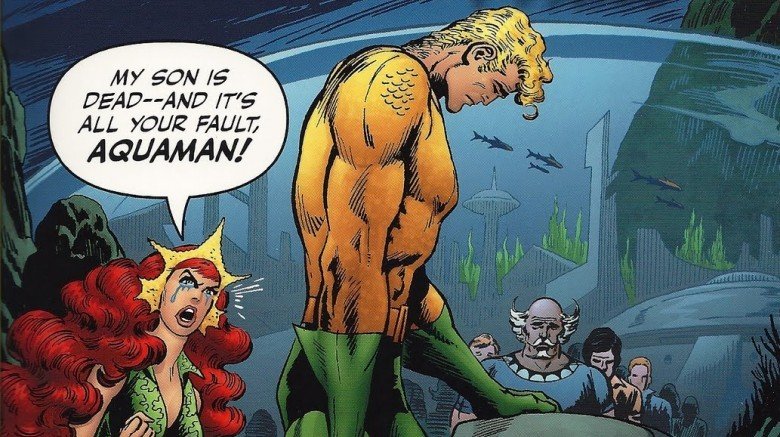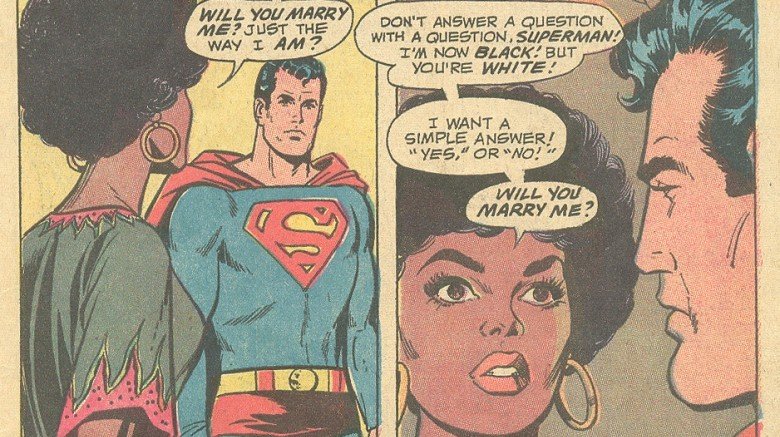The Most Disturbing Moments In DC Comics History
One of the most persistent criticisms leveled at Batman v. Superman: Dawn of Justice was that it was overly dark in its tone. But as longterm readers know, that tone is perfectly in line with much of what DC has published over the years: beneath the veneer of bright capes and costumes lies a world of rape, murder, and multiple instances of sex that can only be described as "illegal and dangerous." If you're ready to read about some of the most disturbing moments in comic book history, then keep going—but be warned: there are some legitimately gross images attached to some legitimately gross events in this article. If you'd like to pretend that the Joker is here to tell Barbara Gordon about a timeshare opportunity, this would be a good time to turn back...
The death of Jason Todd
The character of Jason Todd has had a pretty weird history. He was introduced as the new teenage Robin after Dick Grayson grew up and became Nightwing, but fan reaction to Jason was mixed, and when DC let readers dial one of two numbers to vote on whether he should live or die, he ended up being killed. Now, comics being comics, the character has since been brought back to life and become a hard-edged hero in his own right. However, the details surrounding his original death still make it one of the most disturbing moments in the publisher's long history.
Robin had just discovered his long-lost biological mother, but it turned out she was being blackmailed into helping the Joker. Joker captured Robin, grabs a nearby crowbar, and proceeded to beat the absolute hell out of the Boy Wonder. While DC Comics of the time period typically shied away from gore, this story includes a grim scene in which Joker, with his hand and lower body drenched in blood, laments how messy it's been. In order to make a token effort to hide his involvement with beating Robin, Joker sets a bomb and leaves both the boy and his mother to die in the blast. The explosion is ultimately what kills Robin, but readers will never forget a madman brutally torturing a 15-year old boy until he was covered in the victim's blood.
The Joker's severed face
In the Dark Knight movie, one of Joker's lines to Harvey Dent is that chaos is "fair," and the Joker of the comics seems to embody that idea. Historically, Joker has had weird plans to make the citizens of Gotham more like him via his special Joker venom and gas, but on one occasion, he decided to be more like some of his victims in the grossest possible way: allowing his own face to be cut off.
After allowing himself to be captured and sent to Arkham, the Joker had what seemed to be a prearranged meeting with the Dollmaker, later escaping the asylum and leaving his now cut-off face on the wall as some kind of bizarre message for Batman and the police. When the Joker inevitably returned to crime, he actually retrieved his severed face from police lock-up and spent a good long time wearing it, making his already-scary appearance that much more frightening. Sometimes, for dramatic effect, he'd take it off and peek through the holes.
Superman and Wonder Woman's murder sex
Once upon a time, Frank Miller changed Batman forever by writing The Dark Knight Returns. Just as Miller's Batman: Year One served as a template for much of Batman Begins, The Dark Knight Returns provided inspiration for some of the most memorable scenes in Batman v Superman. However, Miller went on to write sequels to The Dark Knight Returns, which dropped progressively lower in quality even as he ramped up their insanity. In the process, he created one of DC's most disturbing moments when he portrayed Superman and Wonder Woman having sex.
It doesn't sound so bad, right? After all, DC had Superman and Wonder Woman dating as part of their New 52 comics, and the power couple were the stuff of Hot Topic t-shirt legend. However, Frank Miller's over-the-top writing showed that their sex was killing untold numbers of people. How so? As these godlike beings fly up in the air and crash down to the earth during sex, we see earthquakes erupting all over the planet, hurricane winds, Hawaii being evacuated...and all for the payoff of a really dumb pun, with Wonder Woman noting that "the Earth moved." Sure, it's a cute joke, but how many people died due to careless supersex?
Green Lantern the pedophile
Unlike DC heroes such as Batman, Hal Jordan's portrayal as a romantic is very genuine. Whereas Bruce Wayne simply pretends to be a vapid playboy with a bevy of romantic conquests, Hal Jordan is an intergalactic flirt of the first order. And while this is normally presented as part of his space cowboy charm, it led to one of the most disturbing ongoing storylines when he ended up dating a fellow Green Lantern...who happened to be a 13-year-old girl.
The character, named Arisia, was introduced as a teenage girl in the Green Lantern Corps comics, serving as someone young readers could latch onto (much as Kitty Pryde did for young readers of the X-Men). She soon developed a schoolgirl crush on Hal Jordan, but he kept his distance, referring to her as his "little sister" at one point. Later, however, her body matured to that of an adult thanks to her power ring obeying her subconscious commands. Hal ended up dating her, and even made jokes about how it might take a while to convince the rest of the Green Lanterns that he wasn't a child molester. The two stayed together and had an explicitly sexual relationship for a long time, despite the fact that (her protests notwithstanding) she was still 13. They eventually broke up, and Hal stuck with dating people that wouldn't land him on intergalactic broadcasts of To Catch a Predator.
The original woman in the refrigerator
Another Green Lantern (Kyle Rayner instead of Hal Jordan) brought the character under fire of controversy with a moment so disturbing and controversial that it ended up completely changing how comics were written—and it all started with a woman in a refrigerator.
Rayner came home one day and found that his girlfriend, Alexandra DeWitt, had been killed by the supervillain Major Force and then stuffed into the refrigerator. Kyle, sufficiently motivated by anger and regret, ended up stopping the bad guy. However, DC writer Gail Simone (now a legend in her own right) was horrified that the company had consented to kill a female character—and in such a gruesome way—merely to motivate the male protagonist. She coined the term "Women in Refrigerators" for any time women in comics were killed, seriously injured, sexually violated, or de-powered merely to motivate male heroes, and she published a long list of such cases. Kyle's girlfriend was merely the latest in a long line that included characters like Elektra, Gwen Stacy, and Barbara Gordon. While this trope didn't go away overnight and still happens occasionally, the idea of "women in refrigerators" has become a major industry topic of discussion, lending a possible silver lining to this otherwise disturbing moment.
The Killing Joke
Speaking of Barbara Gordon, she's at the center of another disturbing moment in DC history: The Killing Joke, a one-shot comic written by legendary Watchmen scribe Alan Moore. The story involved the Joker breaking loose from Arkham Asylum, kidnapping Commission Gordon, and attempting to drive the man mad, all to prove that it only takes one terrible day to drive anyone crazy (a theme revisited in the Dark Knight movie, in which the Joker believes anyone will do terrible things if the circumstances are bleak enough). Along the way, Joker attacked Barbara Gordon in a way that still has people talking decades later.
Barbara Gordon was, of course, Batgirl, a high-flying fellow adventurer with Batman. Joker shot her through the spine and rendered her unable to walk. Later, while trying to drive Commissioner Gordon crazy, Joker presented pictures he took of Barbara that show Joker took off her clothes and quite possibly raped her. This was a very exploitative moment in an otherwise pretty solid book, and it's one Moore regrets. He claims that when he approached DC Editorial to get permission, he was allegedly told to "cripple the bitch," and has since regretted that DC let him go that far. Barbara eventually became the badass tech hero Oracle and later became Batgirl again, but this instance is often held up as a prime "women in refrigerators" moment. The animated movie adaptation of The Killing Joke doubles down on this idea by adding a sexual relationship between Batman and Batgirl, presumably so Batman has that much more motivation to punish Joker. This angered old and new fans alike, showing that the most disturbing thing about The Killing Joke hasn't lost its noxious power.
The rape of Sue Dibny
One of DC's most disturbing moments kicked off a chain of later story events, and it all started with the Identity Crisis story and the death of Sue Dibny, wife of Ralph Dibny (the Elongated Man), who was horrifically killed and her body burned. While that was disturbing in and of itself, a handful of heroes immediately suspected Dr. Light, a lightweight villain primarily known at the time as a Teen Titans foe. Why? As it turns out, the villain once brutally raped Sue Dibny within the seemingly safe Justice League's satellite base. She was the only one there at the time, and when the heroes arrived, they were too late to prevent Dr. Light from violating her.
When they finally did show up, things took a turn for the weird. Dr. Light threatened to find all of the heroes' loved ones and rape them as a twisted way of getting revenge on those who had wronged him. Since he was clearly capable of carrying out the threat, the heroes made the controversial decision to have the magical Zatanna partially lobotomize him. The idea was to make him less of a threat, but it had the side effect of affecting his mind in other ways, which was used as a retcon to explain why someone who was once a threat to the Justice League became a punching bag for the Teen Titans. The retcon also included the fact that she regularly did this to villains who, for instance, figured out the secret identities of heroes—but Batman disagreed with the practice and Zatanna wiped his mind, too. Thus, one of DC's most controversial stories, the rape of Sue Dibny, ironically kicked off an ongoing debate about the ethics of violating supervillains without their consent.
Arsenal gets high and saves a dead cat
The character of Arsenal has had a rough life. Previously known as Red Arrow (and before that, known as Speedy, the teenage sidekick of Green Arrow), he ended up being addicted to heroin. This addiction threaded throughout Speedy's life over the years, but the character arguably reached his low point when he beat up a bunch of homeless people because of a dead cat that he imagined was his daughter.
Let's start at the beginning. Arsenal was fighting his onetime girlfriend and baby mama, the genocidal villain Cheshire, and their battle turned kinky after he tied her up and they started fooling around. When Arsenal couldn't rise to the occasion, he went out to beat the hell out of some bad guys, then scored some heroin (in his superhero costume, no less). Afterwards, he thought he was protecting his daughter from five versions of the villain Prometheus, but it turned out he was just beating up some people in an alley, and his "daughter" was really a dead cat. Batman showed up to beat some sense into Arsenal, but he was sadly unable to beat the memories of Arsenal's drug-induced, dead cat daughter shenanigans out of readers' minds.
Aquababy's murder
Comic books can be pretty brutal. Sidekicks are murdered, wives and girlfriends are raped and murdered, and it's easy to grow numb to all this of this as a reader. However, one group that we often think of as "off-limits" is children. After all, superhero comics, like fairy tales before them, are usually stories of survival and eventual transformation for children. Characters like Batman, Superman, Green Lantern, and Flash all survive the deaths of one or more parents when they're younger, and the experience makes them stronger. All of this made it that much more shocking when Aquaman's infant son was brutally murdered by his nemesis, Black Manta.
Arthur Curry, Jr., was the son of Aquaman, and if that wasn't already enough of a cross to bear, he sometimes went by the awful name of Aquababy. True to his Atlantean nature, Aquababy could only breathe underwater—so Black Manta kidnapped the child and put him in a special sphere that slowly filled with air. Using Aquababy's life as leverage, Black Manta forced Aquaman to fight his sidekick Aqualad, and by the time the fight was over, Aquababy had straight-up died inside the sphere. This event transformed the comic, leading to strained relations between Aquaman and Aqualad and a divorce between Aquaman and his wife, Queen Mera. If all of this wasn't terrible enough, Black Manta later destroyed the place where Aquababy was buried, forcing readers to revisit that disturbing moment of infanticide all over again.
Lois Lane becomes a black woman
Race has always been a very touchy issue in superhero media. Much of this stems from the fact that the most famous faces for big companies like DC were created between the 1930s and the 1960s, and as a result, DC Comics ended up being a mostly Caucasian occasion. To their credit, the company has tried to tackle race on more than one occasion, but they often end up fumbling the issue. Perhaps the best example is the time Lois Lane decided that in order to report on black people, she would have to become a black woman herself.
In all fairness, it's clear that DC was trying to make a heavy-handed point about how race doesn't need to divide us and that, looking past the differences in the color of our skin, we're all human. However, they did it in the most privileged and cringe-inducing way. Lois was trying to "get the inside story" of "Little Africa," which is apparently the Metropolis equivalent of Harlem. When she was rebuffed as an outsider, she decided the most sane course of action would be to use Superman's freaky alien technology to become a black woman. She learned some valuable realities about racism, but never shook off the perspective of a well-off white woman who saw the black citizens around her as people to be pitied. Worse, the big climax came when she donated blood to a wounded black activist: she lost her magical alien blackness, but was surprised and overjoyed when the activist woke up and accepted her as a white woman. Lois never learned any lasting lessons about race from this, and the story focused instead on her need to be accepted by people she looked down on so she could file her race-related story and further her own career.
